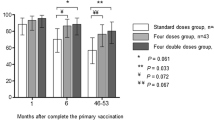Abstract
Objective
To compare the long-term seroprotection (anti-HBs ≥10 IU/L) in children living with HIV (CLHIV) receiving a 3- or 4-dose double-strength (20 µg) recombinant Hepatitis B virus (rHBV) vaccination.
Methods
We present anti-retroviral therapy (ART) clinic based follow-up data collected from January, 2021 to August, 2022, from CLHIV who had received either 3-dose or 4-dose double-strength (20 µg) rHBV vaccination, after 36–42 months and assessed for anti-HBs titres, naïve and memory T-helper lymphocytes, CD4 counts and HIV viral load. Children found unprotected after primary immunization, were administered a single double-strength rHBV vaccine booster dose (20 µg) and seroprotection was reassessed after 4 and 12 weeks.
Results
Out of 50 children initially vaccinated, 45 were followed up 36–42 months after primary immunization; median (IQR) anti-HBs titres (IU/L) were 230 (80.5–305.7) in the 3-dose group (n=23) and 263.5 (47.1–332.9) in the 4-dose group (n=22) (P=0.33). 19 and 20 children in the 3-dose and 4-dose group, respectively, were seroprotected (P=0.24). Anti-HBs titres at 36–42 months correlated with CD4 counts at baseline, anti-HBs titres at 1 and 6 months after completion of primary immunization and percentage of memory T-helper lymphocytes. All the five children (3-dose group: 4; 4-dose group: 1) who received rHBV vaccine booster dose attained seroprotection one-month later.
Conclusion
Three-dose double strength rHBV vaccination schedule offers comparable seroprotection to a 4-dose double strength rHBV vaccination schedule in CLHIV receiving ART.
Similar content being viewed by others

References
Taylor M, Alonso-González M, Gómez B, et al. World Health Organization global health sector strategy on sexually transmitted infections: An evidence-to-action summary for Colombia. Rev Colomb Obstet Ginecol. 2017;68:193–201.
Zuin G, Principi N, Tornaghi R, et al. Impaired response to hepatitis B vaccine in HIV infected children. Vaccine. 1992;10:857–60.
Farooq PD, Sherman KE. Hepatitis B vaccination and waning hepatitis B immunity in persons living with HIV. Curr HIV/AIDS Rep. 2019;16:395–403.
Fonseca MO, Pang LW, Cavalheiro NDP, et al. Randomized trial ofrecombinant hepatitis B vaccine in HIV-infected adult patients comparing a standard dose to a double dose. Vaccine. 2005;23:2902–08.
Flynn PM, Cunningham CK, Rudy B, et al. Hepatitis B vaccination in HIV-infected youth: a randomized trial of three regimens. J Acquir Immune Defic syndr. 2011;54:325–32.
Aberg JA, Gallant JE, Ghanem KG, Emmanuel P, Zingman BS, Horberg MA; Infectious Diseases Society of America. Primary Care Guidelines for the Management of Persons Infected With HIV: 2013 Update by the HIV Medicine Association of the Infectious Diseases Society of America. Clin Infect Dis. 2014;58:1–10.
AIDSinfo. Guidelines for Prevention and Treatment of Opportunistic Infections in HIV-infected Adults and Adolescents. April 16, 2015. Accessed August 1, 2020. Available from: https://aidsinfo.nih.gov/guidelines/html/4/adultand-adolescent-oiprevention-and-treatment-guidelines/344/hbv
Mast EE, Margolis HS, Fiore AE, et al; Advisory Committee on Immunization Practices (ACIP). A Comprehensive Immunization Strategy to Eliminate Transmission of Hepatitis B Virus Infection in the United States: Recommendations of the Advisory Committee on Immunization Practices (ACIP) Part 1: Immunization of Infants, Children, and Adolescents. MMWR Recomm Rep. 2005;54:1–31.
Advisory Committee on Vaccines and Immunization Practices, Indian Academy of Pediatrics. Vaccination of Special Groups. In: Balasubramanian S, Shastri DD, Shah AK, et al (Eds). IAP Guidebook on Immunization 2018–2019. 3rd Edn. New Delhi: Jaypee Medical Publishers Limited. 2018. p.406.
Jain P, Dewan P, Gomber S, et al. Three vs four dose schedule of double strength recombinant hepatitis-b vaccine in HIV-in-fected children: A randomized controlled trial. Indian Pediatr. 2021;58:224–28.
Koc ÖM, van Oorschot E, Brandts L, Oude Lashof A. Timing of primary three-dose hepatitis B vaccination and postvaccination serologic testing among a large cohort of healthy adults. J Med Virol. 2022;94:4433–39.
Launay O, Rosenberg AR, Rey D. Long-term immune response to hepatitis B virus vaccination regimens in adults with human immunodeficiency virus 1: secondary analysis ofa randomized clinical trial. JAMA Intern Med. 2016;176:603–10.
Pessoa SD, Miyamoto M, Ono E, et al. Persistence of vaccine immunity against hepatitis B virus and response to revaccination in vertically HIV-infected adolescents on HAART. Vaccine. 2010;28:1606–12.
Lopes VB, Hassing RJ, de Vries-Sluijs TE, et al. Long-term response rates of successful hepatitis B vaccination in HIV-infected patients. Vaccine. 2013;31:1040–44.
Veiga APR, Casseb J, Duarte AJS. Humoral response to hepatitis B vaccination and its relationship with T CD45RA+(nayve) and CD45RO+ (memory) subsets in HIV-1-infected subjects. Vaccine. 2006;24:7124–28.
Funding
Funding: Intramural research grant for post-graduate thesis (NY).
Author information
Authors and Affiliations
Contributions
Contributors: NY: data collection, analysis and interpretation, drafted the manuscript and revised it; PD: conceptualized the study, data analysis and interpretation, drafted the manuscript and provided critical inputs; SG: data interpretation, critical inputs in manuscript; BK, RG: laboratory methods, data collection and interpretation, provided critical inputs in the manuscript. All authors approved final manuscript and are accountable for the contents.
Corresponding author
Ethics declarations
Ethics clearance: Institutional Ethics Committee for Human Research of University College of Medical Sciences; No.: IECHR/2020/PG/68-R1 dated Dec 21, 2020.
Competing interest: None stated.
Additional information
Note: V Balagopal Raju Award (second prize) at the PEDICON 2023 of the Indian Academy of Pediatrics, Gujarat (NY).
Rights and permissions
About this article
Cite this article
Yadav, N., Dewan, P., Gomber, S. et al. Seroprotection With Three Dose vs Four Dose Schedule for Hepatitis B Vaccination in Children Living With Human Immunodeficiency Virus: Follow-up Data at 36–42 Months From a Randomized Controlled Trial. Indian Pediatr 60, 935–938 (2023). https://doi.org/10.1007/s13312-023-3040-9
Received:
Revised:
Accepted:
Published:
Issue Date:
DOI: https://doi.org/10.1007/s13312-023-3040-9



